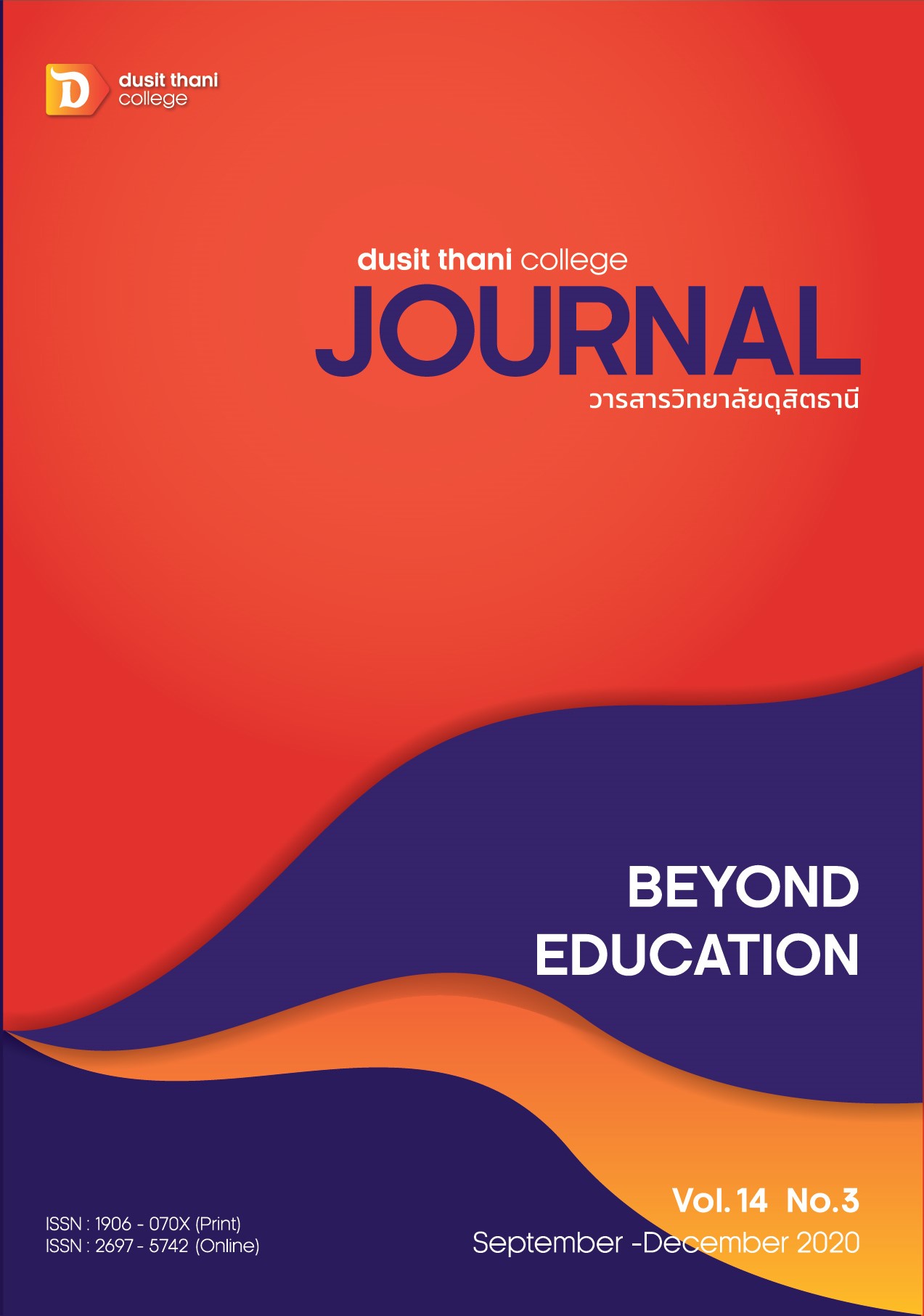Causal Relationship Model affecting Tourist Loyalty of a Secondary City on the East Coast
Main Article Content
Abstract
The purpose of this research was to study the causal relationship affecting tourist loyalty of a Secondary City on the East Coast. The data was collected from 1,050 tourists of a Secondary City on the East Coast by Multi-Stage Sampling. The tool used for data collection was a 5-level rating scale questionnaire with content validity value (S-CVI/Ave) 0.88 and a reliability coefficient of 0.98. The causal relationship model was performed with the Amos program. The results showed that Service Quality, Tourism Image, and Satisfaction were affected by the loyalty of tourists with the most affected being Satisfaction. From the above results, the strategy of development of a Secondary City on the East Coast showed that there is a necessity for public relations regarding a place that tourists will always want to visit, ensuring that beautiful sights and attractions are always properly maintained. The causal relationship affecting tourist loyalty of a secondary city on the East Coast was congruent with the empirical data according to the statistical values of Chi square = 50.10, df=36, p-value=0.06, relative Chi-square (c2/df)=1.39, GFI=0.99, AGFI=0.98, CFI=0.99, NFI=0.99, TLI=0.99 RMR=0.00, RMSEA=0.019. The contribution of this research was the development of sustainable tourism guidelines.
Article Details
Article Screening Policy
- All research and academic articles to be published must be considered and screened by three peer reviews in the relevant field / article.
- All articles, texts, illustrations and tables published in the journal are the personal opinions of the authors. Editors don't always have to agree. And no responsibility whatsoever is the sole responsibility of the author.
- The articles to be published must never be published. Where did you first publish? And not in the consideration of other journals If the audit found that there has been a duplicate publication It is the sole responsibility of the author.
- Any article that the reader sees as being plagiarized or impersonated without reference. Or mislead the work of the author Please let the journal editor know it will be your greatest blessing.
References
London: CABI.
Charoensuk, Sh & U-on, V. (2019). The Causal Factors Influencing the Perceived Value, Satisfaction of Service Quality and Destination Image of Historical Attractions
(World Heritage Sites) of Ayutthaya Historical Park -Sukhothai -Sisatchanalai and the Kamphaeng Phet of Thailand. Al-HIKMAH Journal, 9(18), 147-167. (in Thai)
Chen, C., & Tsai, D. (2007). “How Destination Image and Evaluative Factors Affect Behavioral
Intentions?”. Tourism Management, 28(1), 1115-1122.
Darnell, A. C., & Johnson, P. S. (2001). Repeat Visits to Attractions: a Preliminary Economic
Analysis. Tourism management, 22(2), 119-126. http://dx.doi.org/10.1016/S0261-
5177(00)00036-4.
Gallarza, M.G., & Saura, I.G. (2006). Value dimensions, perceived value, satisfaction and
loyalty: An investigation of university students’ travel. Tourism Management,
27(2), 437-452.
Jaisom, P., Toopgrajank, S., Charoenwiriyakul, Ch., Boonpadung, P. & Tipayatikumporn, U. (2020). Antecedents of Sustainable of Less Visited Area Tourism. Journal of MCU Peace Studies, 8(1), 133-144.
Jayarman, K., Lin, S. K., Guat, C. L., & Ong, W. L. (2010). Does Malaysian Tourism Attract
Singaporeans to Revisit Malaysia, Journal of Business and Policy Research, 5(2),
159-179.
Kanokwongpaisarn, N., Saengpayap, P., Khemthong, S. & Ingsrisawang, L. (2019). An Integrated Model of the Relationships of destination Image, place Attachment, Perceived Value, Satisfaction, and Tourist Loyalty in the Andaman Coastal Provinces. Modern Management Journal, 17(2), 9-24. (in Thai)
Kamphaengphet, M., khamsuk, V., Sinuan, N., kukiatsakunman, S. & Phuphueak, A. (2016). Factors influencing destination loyalty of Chinese tourists in Eastern Province Cluster Thailand. Business Review Journal, 8(1), 137-154. (in Thai)
Kieanwatana, k. (2018). The Early Adult Chinese’s Attitude towards Tourism Image of Thailand Singapore and Malaysia, Journal of Thai Hospitality and Tourism, 13(2), 16-24. (in Thai)
Ministry of Tourism & Sports. (2019). “Tourism Authority of Thailand. Trat is open to more than 2 million tourists - Spread nearly 20 billion”. Retrieved 5 May 2020, from https://siamrath.co.th/n/106192. (in Thai)
Ministry of Tourism & Sports. (2018). “Chanthaburi tourist statistics” Retrieved 5 May 2020, from https://chanthaburi.mots.go.th/ewtadmin/ewt/chanthaburi/graph_views.php?graph_id=40. (in Thai)
Parasuraman, A., Berry, L. L., & Zeithaml, V. A. (1991). Servire la qualità. New York:
McGraw-Hill.
Phatthanarangsak, Ph. (2017). The Estimation of International Tourism Demand Share for Thailand by Characteristic Model]. Economics and Public Policy Journal, 9(17), 67-87. (in Thai)
Qu, H., Ryan, B., & Chu, R. (2000). The importance of hotel attributes in contributing to travelers' satisfaction in the Hong Kong hotel industry. Journal of Quality Assurance in Hospitality & Tourism, 1(3), 65-83.
Schumacher, R. E. & Lomax, R. G. (2016). A Beginner’s Guide to Structural Equation Modeling. (4th Edition). New York: Routledge.
Soonsan, N., & Sukahbot, S. (2020). Causal Relationships between Destination Image, Place Attachment, Overall Satisfaction, and Behavioral Intention of Western Tourists in Phuket. Chulalongkorn Business Review, 42(1), 68-83. (in Thai)
Tourism Authority of Thailand. (2018).“Amazing Thailand Go Local Community Tourism Growing Community Growing Thailand”. Retrieved 17 April 2018, from https://thai.tourismthailand.org/. (in Thai)
Tongkaw, A., Thakerngkiat, S. Ngamwongnoi, P. & Suksawang, P. (2019). The Tourism Image Influencing Loyalty of Tourists at Bali Hai, Pattaya Stepping into the Eastern Economic Corridor. Dusit Thani College Journal, 13(2), 67-82. (in Thai)
Tongkaw, A. & Saethow, P. (2018). The Determinants of Demand Affecting to Loyalty of Tourists at Ancient Chinese Chakngeaw Market Community Pattaya City.
Dusit Thani College journal, 12(Special), 220-230. (in Thai)
Wang, X., Zhang, J., Gu, C., and Zhen, F. (2009). Examining antecedents and consequences
of tourist satisfaction: A structural modeling approach. Tsinghua Science and
Technology, 14 (3), 397-406.


